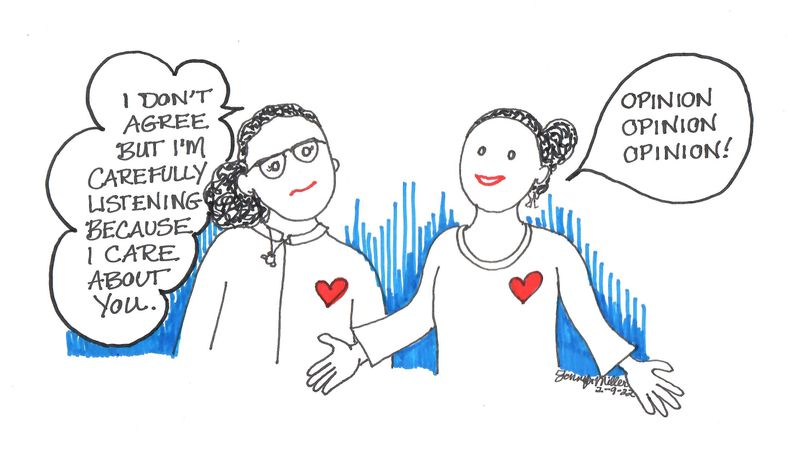18 Polite But Powerful Ways To Disagree Without Starting A Fight
Navigating disagreements can be challenging, especially when emotions run high. However, it’s possible to express differing opinions without escalating into conflict. This blog post offers 18 ways to disagree politely yet powerfully.
Each tip encourages maintaining respect and understanding while firmly standing your ground. The goal is to foster constructive dialogue and preserve relationships, whether personal or professional.
These strategies emphasize clarity and composure over volume and aggression, offering a balanced approach to conflict resolution.
Employing these techniques can help you communicate more effectively, ensuring your voice is heard without silencing others. Read on to discover how to hold your ground gracefully in conversations that matter.
1. I Hear You

“I hear you, I just don’t share the same view.” This phrase validates the other person’s perspective while gently asserting your own stance. It opens the door for dialogue, rather than confrontation. The art lies in the delivery—calm, composed, and with genuine interest in understanding the other side.
This approach maintains the dignity of both parties involved and promotes a healthy exchange of ideas. By using this phrase, you convey that differences are natural and can be discussed openly. Remember, the goal isn’t to ‘win’ the argument, but to communicate effectively.
2. Slow Down, Respond

“Can we slow this down? I want to respond, not react.” This request encourages a pause in the conversation, allowing emotions to settle and thoughtful responses to form. Hasty reactions often lead to misunderstandings, so taking a step back can be incredibly beneficial.
This phrase underscores the importance of mindfulness in communication, reinforcing the idea that it’s better to think things through than to rush to a conclusion. It shows respect for both your feelings and those of the person you’re talking to, fostering a more productive dialogue.
3. Respectful Disagreement

“I respect where you’re coming from, even if I don’t agree.” This statement balances respect and disagreement, showing that differing views can coexist without hostility. Acknowledging the validity of the other’s feelings while presenting your own perspective can create a harmonious discussion.
It’s an invitation to explore rather than to argue. The beauty of this approach is in its ability to maintain rapport while addressing differences. It’s a gentle reminder that respect doesn’t equate to agreement, but it fosters understanding and collaboration.
4. Stick to Facts

“Let’s talk about facts—not just feelings or assumptions.” Steering the conversation towards facts rather than emotions can de-escalate potential conflicts. Facts provide a common ground from which to build understanding. This statement helps to clarify issues, promoting a more rational and less emotional exchange.
By focusing on objective information, you can navigate the conversation more effectively, minimizing misunderstandings and keeping the discussion on track. It’s a strategy that values evidence and logic over impulsive reactions, enhancing the quality of communication.
5. Importance of Being Heard

“This is important to me, and I want to be heard clearly.” Asserting the importance of your perspective encourages others to listen more attentively. It signals that the issue at hand holds personal significance, which can prompt more empathetic engagement from others.
By stating your need to be heard, you acknowledge the value of your own voice, setting the stage for a more balanced dialogue. This approach helps in ensuring that conversations are not one-sided, fostering mutual respect and a deeper understanding.
6. Pause for Productivity

“Can we pause? I want this to stay productive.” Proposing a pause can prevent conversations from spiraling into unproductive arguments. It gives both parties time to reflect and return to the discussion with a clearer perspective.
This technique is useful in maintaining the focus on finding solutions rather than dwelling on problems. By suggesting a break, you express a commitment to constructive dialogue and demonstrate leadership in steering the conversation towards a positive outcome.
7. Different Perspectives

“I see it differently—and here’s why.” Offering your perspective in this manner invites curiosity and consideration, rather than confrontation. It encourages the other person to explore your viewpoint without feeling challenged.
This approach emphasizes the diversity of thought, inviting a richer conversation. By explaining your reasoning, you provide context that can lead to greater empathy and understanding. It’s an opportunity to educate and enlighten, transforming potential conflicts into learning experiences.
8. Naming Discomfort

“That doesn’t sit right with me, and I want to name it.” Addressing discomfort directly can prevent it from festering into resentment. By naming what’s bothering you, you open the door to address it constructively. This tactic helps in clarifying misunderstandings and setting boundaries.
It’s a brave step towards resolving issues before they escalate. Transparency in communication builds trust and shows a willingness to engage honestly. It’s about creating a safe space for both parties to express themselves freely.
9. Honest Over Agreeable

“I’d rather be honest than agreeable right now.” Prioritizing honesty over superficial harmony can lead to more authentic interactions. While it might feel uncomfortable, honesty paves the way for genuine understanding and respect. It demonstrates integrity and courage.
This phrase encourages both parties to engage in a more meaningful dialogue, focusing on truth rather than convenience. By choosing honesty, you create opportunities for growth, both personally and within the relationship. It’s a commitment to authenticity over appeasement.
10. Better Timing

“Let’s revisit this when we’re both in a better space.” Timing can greatly influence the quality of a conversation. Suggesting to pause and return to the topic later can prevent unnecessary conflicts. This strategy respects both parties’ emotional states, ensuring the discussion happens when both can contribute positively.
By recognizing when emotions are tense, you avoid escalating conflicts and promote more productive discussions. It’s a mature approach to handling disagreements, putting the relationship and understanding first.
11. Valuing Relationships

“I value this relationship too much to let this become a fight.” Emphasizing the importance of the relationship can diffuse tension and redirect the focus towards mutual respect. This statement acts as a reminder of shared interests and common goals.
It’s an affirmation that the relationship matters more than the disagreement itself. By prioritizing the bond, you encourage collaboration in resolving issues. It fosters a spirit of teamwork and empathy, ensuring that disagreements don’t overshadow the positive aspects of the relationship.
12. Caring From Different Angles

“It sounds like we care about the same thing—but from different angles.” Recognizing common ground in values or goals can transform disagreements into constructive discussions. This phrase highlights the shared intentions behind differing viewpoints.
By acknowledging this, you bridge gaps and encourage cooperation. It’s about finding unity in diversity, where both parties can appreciate each other’s contributions to the conversation. This approach promotes a deeper connection and understanding, allowing disagreements to become opportunities for growth and collaboration.
13. Silent No More

“I don’t want to argue, but I can’t stay silent on this.” Breaking silence to address issues is a powerful step towards resolution. It signals a commitment to honesty and transparency. This statement balances the need to express oneself with a desire to avoid confrontation.
It encourages open dialogue while maintaining respect for differing opinions. By speaking up, you invite conversation rather than conflict. It’s about finding the courage to voice concerns constructively, fostering a culture of openness and trust.
14. Sharing Perspectives

“I get where you’re coming from. Here’s my perspective.” Bridging understanding through shared perspectives enriches the conversation. This phrase acknowledges the other person’s viewpoint while introducing your own, fostering mutual respect. It encourages exploration and empathy, allowing both parties to learn from each other.
By framing your perspective as part of a broader dialogue, you invite collaboration rather than confrontation. It’s an approach that values diversity of thought as a strength, promoting deeper connections through shared understanding.
15. Stay Curious

“Let’s stay curious—not combative.” Encouraging curiosity over confrontation opens the door to learning and growth. It invites both parties to explore new ideas and understandings, rather than defending their positions.
Curiosity fosters a safe environment for dialogue, where questions are welcomed, and assumptions are challenged. By prioritizing curiosity, you transform potential conflicts into collaborative problem-solving opportunities. It’s about embracing differences as avenues for exploration, promoting a more inclusive and dynamic exchange of ideas.
16. Misunderstanding, Not Opposition

“I think we’re misunderstanding each other, not actually opposing.” Recognizing misunderstandings can prevent them from becoming full-blown conflicts. This phrase shifts the focus from opposition to clarity, encouraging both parties to explore the roots of their disagreement.
It promotes a more compassionate approach to communication, where the goal is to understand rather than to argue. By addressing misunderstandings, you pave the way for deeper connections and improved communication. It’s a strategy that values resolution and empathy over winning an argument.
17. Space for Thought

“I need space to think this through before I respond.” Taking time to process thoughts before responding can lead to more thoughtful and effective communication. This request for space respects both your need for reflection and the integrity of the conversation.
It prevents rash reactions that might escalate tensions and allows for more considered responses. By valuing time for thought, you signal a commitment to meaningful dialogue. It’s a mature way to ensure that responses are measured and respectful, enhancing the quality of the interaction.
18. Agree to Disagree Respectfully

“This is one of those times I’ll agree to disagree—with respect.” Embracing respectful disagreement acknowledges that not all differences need to be resolved. It’s an acceptance of diversity in thought and opinion. This phrase reinforces the idea that relationships can thrive despite unresolved differences.
By agreeing to disagree, you maintain mutual respect and understanding, ensuring that the relationship remains intact. It’s about prioritizing harmony over uniformity, accepting that agreement isn’t always possible, but respect always is.


